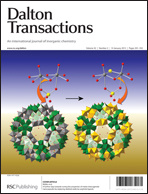Rate constants for the reactions of cyanamide anion N![[triple bond, length as m-dash]](https://www.rsc.org/images/entities/char_e002.gif) C–NH− with Fischer carbene complexes of the type (CO)5M
C–NH− with Fischer carbene complexes of the type (CO)5M![[double bond, length as m-dash]](https://www.rsc.org/images/entities/char_e001.gif) C(XR)C6H4Z with M = Cr and W, XR = SMe and OMe, Z = NMe2, OMe, Me, H, F, Cl and CF3 in 50% MeCN–50% water (v/v) at 25 °C are reported. N
C(XR)C6H4Z with M = Cr and W, XR = SMe and OMe, Z = NMe2, OMe, Me, H, F, Cl and CF3 in 50% MeCN–50% water (v/v) at 25 °C are reported. N![[triple bond, length as m-dash]](https://www.rsc.org/images/entities/char_e002.gif) C–NH− shows a much higher reactivity towards these carbene complexes than OH−, primary aliphatic amines (e.g. n-butylamine) or secondary alicyclic amines (e.g. piperidine) but is slightly less reactive than thiolate ions (e.g. HOCH2CH2S−). The alkoxy carbene complexes were found to react faster than the thiomethyl derivatives, consistent with previous findings for alkoxide ion, CH(CN)2−, OH−, amine and thiolate ion nucleophiles. Hammett ρ values are 3.00 ± 0.08 (k1) and 2.98 ± 0.08 (k2) for Cr–OMe–Z–N
C–NH− shows a much higher reactivity towards these carbene complexes than OH−, primary aliphatic amines (e.g. n-butylamine) or secondary alicyclic amines (e.g. piperidine) but is slightly less reactive than thiolate ions (e.g. HOCH2CH2S−). The alkoxy carbene complexes were found to react faster than the thiomethyl derivatives, consistent with previous findings for alkoxide ion, CH(CN)2−, OH−, amine and thiolate ion nucleophiles. Hammett ρ values are 3.00 ± 0.08 (k1) and 2.98 ± 0.08 (k2) for Cr–OMe–Z–N![[triple bond, length as m-dash]](https://www.rsc.org/images/entities/char_e002.gif) C–NH− reactions and 0.94 ± 0.05 (k1) for Cr-SMe-Z–N
C–NH− reactions and 0.94 ± 0.05 (k1) for Cr-SMe-Z–N![[triple bond, length as m-dash]](https://www.rsc.org/images/entities/char_e002.gif) C–NH− reactions. The ρ values for the reaction of Cr-OMe-Z and Cr-SMe-Z with CH(CN)2− and DABCO (1,4-diazabicyclo[2.2.2]octane) (in 50% MeCN–50% H2O (v/v) are comparable to the present reactions. The much higher reactivity and hence much higher ρ value for methoxy carbene complexes over the corresponding thiomethyl derivatives is best explained by considering the substituent effects not only on the transition state (TS) but also on the reactant, and consistent with the previously observed pattern. Higher k1(W)/k1(Cr) ratios for (thiomethyl)carbene complexes as well as methoxy and ethoxycarbene complexes are related to the intrinsic rate constant which is higher for tungsten–carbene complexes than the corresponding Cr ones resulting in an enhanced ratio. This can also be explained by considering the electronegativity of Cr and W, which is higher for the latter; as a result the negative charge on the central metal atom is more localized in case of W causing destabilization of the TS and hence higher reactivity.
C–NH− reactions. The ρ values for the reaction of Cr-OMe-Z and Cr-SMe-Z with CH(CN)2− and DABCO (1,4-diazabicyclo[2.2.2]octane) (in 50% MeCN–50% H2O (v/v) are comparable to the present reactions. The much higher reactivity and hence much higher ρ value for methoxy carbene complexes over the corresponding thiomethyl derivatives is best explained by considering the substituent effects not only on the transition state (TS) but also on the reactant, and consistent with the previously observed pattern. Higher k1(W)/k1(Cr) ratios for (thiomethyl)carbene complexes as well as methoxy and ethoxycarbene complexes are related to the intrinsic rate constant which is higher for tungsten–carbene complexes than the corresponding Cr ones resulting in an enhanced ratio. This can also be explained by considering the electronegativity of Cr and W, which is higher for the latter; as a result the negative charge on the central metal atom is more localized in case of W causing destabilization of the TS and hence higher reactivity.

You have access to this article
 Please wait while we load your content...
Something went wrong. Try again?
Please wait while we load your content...
Something went wrong. Try again?
![[triple bond, length as m-dash]](https://www.rsc.org/images/entities/char_e002.gif) C–NH− with Fischer carbene complexes of the type (CO)5M
C–NH− with Fischer carbene complexes of the type (CO)5M![[double bond, length as m-dash]](https://www.rsc.org/images/entities/char_e001.gif) C(XR)C6H4Z with M = Cr and W, XR = SMe and OMe, Z = NMe2, OMe, Me, H, F, Cl and CF3 in 50% MeCN–50%
C(XR)C6H4Z with M = Cr and W, XR = SMe and OMe, Z = NMe2, OMe, Me, H, F, Cl and CF3 in 50% MeCN–50% ![[triple bond, length as m-dash]](https://www.rsc.org/images/entities/char_e002.gif) C–NH− shows a much higher reactivity towards these carbene complexes than OH−,
C–NH− shows a much higher reactivity towards these carbene complexes than OH−, ![[triple bond, length as m-dash]](https://www.rsc.org/images/entities/char_e002.gif) C–NH− reactions and 0.94 ± 0.05 (k1) for Cr-SMe-Z–N
C–NH− reactions and 0.94 ± 0.05 (k1) for Cr-SMe-Z–N![[triple bond, length as m-dash]](https://www.rsc.org/images/entities/char_e002.gif) C–NH− reactions. The ρ values for the reaction of Cr-OMe-Z and Cr-SMe-Z with CH(CN)2− and DABCO (
C–NH− reactions. The ρ values for the reaction of Cr-OMe-Z and Cr-SMe-Z with CH(CN)2− and DABCO (

 Please wait while we load your content...
Please wait while we load your content...